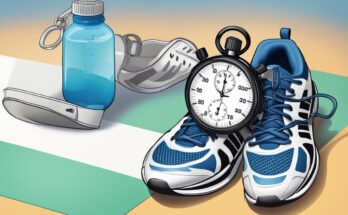Regular exercise is essential for maintaining good health, and running is one of the most popular forms of cardiovascular activity. However, the question of whether it is better to run every day or every other day is a common one among fitness enthusiasts. While some argue that running every day is necessary to build endurance and improve fitness, others believe that taking rest days is crucial for injury prevention and muscle recovery.
When it comes to running, rest and recovery are just as important as the workout itself. Running every day can increase the risk of overuse injuries, such as shin splints and stress fractures, as well as lead to burnout and fatigue. On the other hand, taking rest days allows the body to repair and rebuild muscles, which can improve performance and reduce the risk of injury. Additionally, incorporating cross-training activities, such as cycling or yoga, on rest days can provide a variety of benefits and help prevent muscle imbalances.
The Benefits of Running Every Day
Improved Cardiovascular Health
Running every day can have a positive impact on cardiovascular health. Regular running can lower blood pressure, reduce the risk of heart disease, and improve heart function. Running helps to strengthen the heart muscle, which allows it to pump more blood with each beat. This increased blood flow can help to lower cholesterol levels and reduce the risk of developing cardiovascular disease.
Increased Endurance and Stamina
Running every day can also help to increase endurance and stamina. When you run regularly, your body adapts to the demands of running and becomes more efficient at using oxygen. This increased efficiency can help you to run longer distances and at a faster pace. Additionally, running every day can help to improve your overall fitness level, which can make it easier to perform other physical activities.
Mood Enhancement
Running every day can also have a positive impact on mood. Regular exercise has been shown to release endorphins, which are chemicals in the brain that can improve mood and reduce stress. Running can also help to reduce anxiety and depression, and improve overall mental health.
Overall, running every day can have many benefits for physical and mental health. However, it is important to note that recovery days are also important to prevent burnout and reduce the risk of injury, such as stress fractures. Elite runners may be able to run every day, but for most people, it is important to listen to your body and take rest days when needed.
When it comes to osteoporosis and sustainability, running can have both positive and negative effects. Running can help to improve bone density, which can reduce the risk of osteoporosis. However, running can also put stress on the body, which can lead to injury and other negative effects. It is important to find a balance between physical activity and recovery to prevent burnout and injury.
In conclusion, running every day can have many benefits for physical and mental health, but it is important to listen to your body and take rest days when needed.
The Risks of Running Every Day
Regular exercise is essential for maintaining good health, and running is an excellent form of exercise. However, running every day without adequate rest can lead to several risks. In this section, we will discuss the risks of running every day.
Risk of Overuse Injuries
One of the most significant risks of running every day is overuse injuries. Overuse injuries occur due to the repetitive strain on the same muscles and joints, leading to wear and tear. Shin splints, stress fractures, and muscle imbalances are common overuse injuries associated with running.
Experienced runners are at higher risk of overuse injuries due to the increased wear and tear on their bodies. Therefore, it’s essential to incorporate rest days into your running schedule to allow your body to recover.
Risk of Burnout and Fatigue
Running every day can also lead to burnout and fatigue. Overtraining can lead to physical and mental exhaustion, decreased cognitive function, and increased cortisol levels. This can negatively impact your overall physical and mental health.
To avoid burnout and fatigue, it’s essential to incorporate variety into your running routine. This can include different types of runs, such as interval training, hill repeats, and tempo runs. Cross-training with weightlifting or other forms of exercise can also help improve muscle mass and cardiovascular fitness.
Pros and Cons
While running every day can lead to several risks, it also has its benefits. Running every day can help improve aerobic capacity and physical fitness. Elite runners often run every day to improve their performance and build endurance.
However, for most people, running every other day can be a more sustainable and safe approach. It allows for adequate rest and recovery while still reaping the benefits of running.
In conclusion, running every day can lead to several risks, including overuse injuries, burnout, and fatigue. It’s essential to incorporate rest days and variety into your running routine to avoid these risks. While running every day can have its benefits, it’s not suitable for everyone, and running every other day can be a more sustainable approach.
The Benefits of Running Every Other Day
Reduced Risk of Injury
Running every other day can help reduce the risk of injury. Rest days are crucial for the body to recover from the demands of running. Running every day can lead to overuse injuries, such as shin splints, stress fractures, and muscle imbalances. By taking a day off between runs, the body has time to repair and rebuild muscles, reducing the risk of inflammation, micro-tears, and wear and tear.
Better Rest and Recovery Time
Running every other day allows for better rest and recovery time. Rest days allow the body to repair and recover, reducing the risk of fatigue and burnout. Running every day can lead to mental and physical fatigue, which can negatively impact performance and motivation. Rest days also provide an opportunity for the body to replenish glycogen stores, leading to improved endurance and speed during runs.
Opportunity for Cross-Training
Running every other day provides an opportunity for cross-training. Cross-training can help improve cardiovascular fitness, strengthen different muscle groups, and prevent overuse injuries. Cycling, swimming, strength training, yoga, and other forms of physical activity can complement a running program and provide variety to prevent boredom and burnout. Cross-training can also help improve overall fitness and reduce the risk of common diseases, such as cardiovascular disease and cancer.
In summary, running every other day can provide numerous health benefits, including reduced risk of injury, better rest and recovery time, and an opportunity for cross-training. By following guidelines and listening to the body, runners can create a sustainable and effective training plan that meets their individual training goals.
The Risks of Running Every Other Day
Reduced Cardiovascular Benefits
Running every other day can reduce the cardiovascular benefits that come with regular exercise. Cardiovascular disease is a leading cause of death worldwide, and regular physical activity, including running, can help reduce the risk of developing heart disease. However, research has shown that the benefits of exercise on cardiovascular health are reduced when exercise is performed intermittently, such as running every other day.
Less Consistent Training
Running every other day can also lead to less consistent training. Consistency is key when it comes to improving fitness and endurance. When someone runs every day, they are more likely to develop a routine and stick to it. This consistent training can help improve both physical and mental health.
In contrast, running every other day can lead to a lack of routine and make it harder to maintain a consistent training schedule. This can make it more difficult to achieve fitness goals and improve endurance.
Increased Risk of Injury
Running every other day can also increase the risk of injury. Recovery days are important for allowing the body to rest and recover from the stress of exercise. Without adequate recovery time, the risk of stress fractures and other injuries may increase.
Elite runners often follow a training schedule that includes running every day, but they also incorporate recovery days and cross-training to help prevent injury and burnout. For the average person, however, running every day may not be sustainable or necessary.
In conclusion, while running every other day may be a good option for some people, it does come with some risks. Reduced cardiovascular benefits, less consistent training, and an increased risk of injury are all factors to consider when deciding on a training schedule. It is important to listen to your body and find a routine that works for you and your goals.
Conclusion
In conclusion, whether it is better to run every day or every other day depends on various factors such as fitness goals, body type, and overall health. Both running every day and every other day have their own advantages and disadvantages.
Running every day can help improve cardiovascular health, endurance, and mental well-being. It can also help develop a consistent routine and make running a habit. However, running every day can also increase the risk of injury, especially if the runner is not allowing enough time for recovery and rest.
On the other hand, running every other day can help prevent injury and provide ample time for recovery. It can also help build strength and endurance during the rest days. However, running every other day may not be sufficient for achieving certain fitness goals and may not provide the same mental health benefits as running every day.
Ultimately, the decision to run every day or every other day should be based on individual fitness goals, body type, and overall health. It is important to listen to your body and adjust your running routine accordingly. Incorporating cross-training, stretching, and rest days can also help prevent injury and improve overall fitness.




